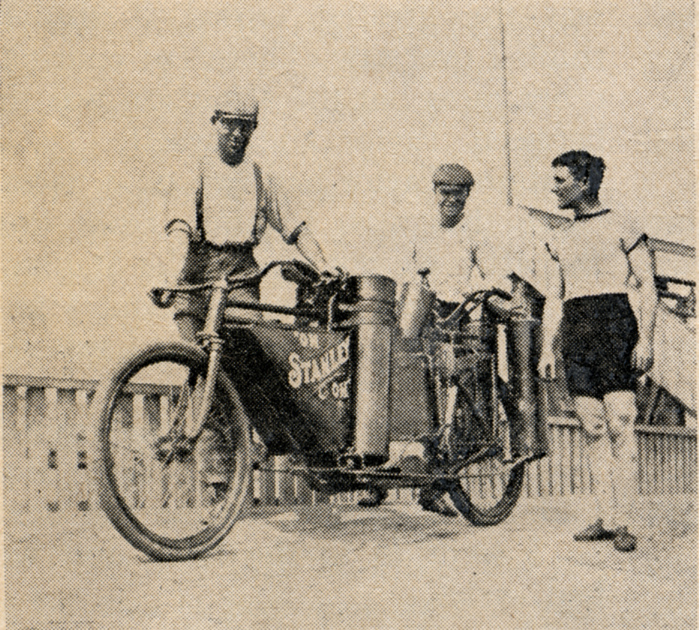| The first bikes were
push-bikes that had no
pedals and were propelled by the rider's feet pushing against the ground.
Then came the high-wheelers (also known as
"penny-farthing")
with their huge front wheel and small rear wheel which were nearly
impossible to ride. Finally the "safety bicycle" appeared which
offered wheels of equal size and a set of pedals to drive the rear wheel
through a chain linkage. Becoming highly popular as a mode of
personal transportation, especially in cities, the bicycle soon found it's
way to becoming a racing vehicle.
Roper attached a twin-cylinder steam engine to a forged-iron and hickory velocipede frame. Roper's bike, which rolled on iron-shod wooden wheels, had a 49" wheelbase. He affixed one steam cylinder of 2-1/4" bore by 2-1/2" stroke to either side of the frame behind the seat and connected the piston rods to cranks providing a on the rear wheel axle. Solid wheels made for a very uncomfortable ride. A firebox and boiler were suspended on springs from the frame between the wheels. Piston valves for the cylinders were operated by eccentrics adjacent to their cranks, and a feed-water pump was operated by the left-cylinder crank. The exhaust steam, carried by tubing into the base of the chimney, provided forced draft to a short chimney projected up from behind the saddle. A charcoal fire heated the water to generate steam to power the engine. Water was supplied from a reservoir that was part of the seat using a feed-water pump operated by the left-cylinder crank.
Roper's steam-powered bike proved popular at exhibitions but hiss neighbors weren't thrilled with the contraption due to it being noisy as well as smelly. The motocycle would often spook horses and tended to annoy those walking the streets. Roper was once arrested on one of his rides, but was released when no laws could be cited that he was breaking. Gottlieb Daimler (who later teamed up with Karl Benz to form the Daimler-Benz Corporation) is often credited with building the first motorcycle in 1885. With Diamler's introduction of the internal combustion engine to the bicycle, like a similar transformation with the steam carriage, the internal combustion engine would soon become the engine of choice for powering bicycles.
Thinking that he could beat that time he
tried it again. A week earlier he had operated the bike unofficially
at an average speed of about 40 mph so he attempted to make the higher
speed an official record. As he circled the 1/3-mile wooden track,
but he went into a big wobble on the back straight and was thrown off the
track and into the sand surrounding it. When assistance arrived to
help him it was apparent that Roper had died in the incident. It was later
determined that he had died of heart failure, not as a result of the
accident itself.
Roperís two-wheeled invention along with his many innovations provided inspiration and direction for inventors during the gas-powered motorbike era that soon followed. Both of Roperís steam-powered bicycles still exist with the Smithsonian Institutionís National Museum of American History owning his original steam bike (photo at right). The steam bicycle was perhaps never a practical means of transport. Problems of carrying enough water and fuel paled in comparison to the prospects of having a boiler, operating at nearly 300 degrees Fahrenheit, between the rider's legs. One area that the steam bicycle did show promise was as a pacing bike for racers. Because a steam engine can operate at slow speed and have tremendous torque, they make an ideal power plant for the slow constant speeds required for pacing bikes. For more photos of steam-powered bicycles, visit http://www.flickr.com/photos/garciavince
The Stanley twins built at least one pacing bicycle for famed racer Eddie McDuffee. Using a Stanley steam-powered he set a machine-paced mile record of 1 minute, 32 seconds in June 1899 at Buttonwood track in New Bedford. McDuffee supplied a $100 frame to the Stanley twins who outfitted it with a boiler and steam engine. After the Stanley twins sold their steamcarriage business to Walker and Barber in 1899, the plans for their pacing bike also became properly of Locomobile. Advertised as "The Fast Pacing Machine in the World" by Locomobile the "Lococycle Model 6" boasted a pair of 14" diameter by 13" tall boilers, a 2.5:1 gear ratio, 2.5" bore x 3.5" stroke dual-cylinder steam engine, and 28" x 2.5" tires. Locomobile offered the Stanley-designed Model 6 in their 1900 catalog. The Lococycle was operated by a tandem team - the front rider or "steersman" was responsible for steering only, while the mechanic in the rear handled the throttle, brakes, and all of the burner/boiler controls. It is unknown if any were ever sold or even constructed. If nothing else the sight of a the prototype Stanley Lococycle operating at Charles River Park Bicycle Race Course may have caught the eye of Fred Marriott who eventually joined the Stanley twins and set the world speed record of 127 MPH on the sands of Ormond Beach, Florida in 1906 driving the Stanley Rocket. To learn more about the Stanley Steamer please click here. STANLEY STEAM CAR |
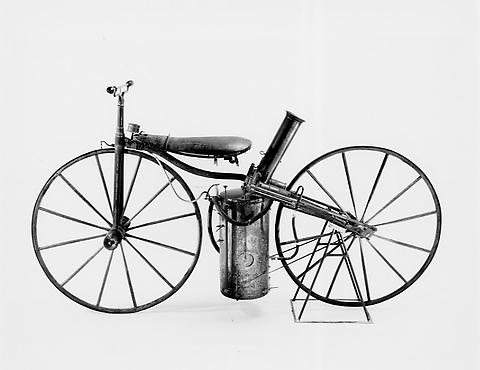 With the steam
engine becoming more common to power mills and factories, it wasn't long
before experiments to adopt the steam engine to the bicycle began.
The first successful marriage of a light-weight steam engine to a bicycle
frame occurred in 1867 when
With the steam
engine becoming more common to power mills and factories, it wasn't long
before experiments to adopt the steam engine to the bicycle began.
The first successful marriage of a light-weight steam engine to a bicycle
frame occurred in 1867 when 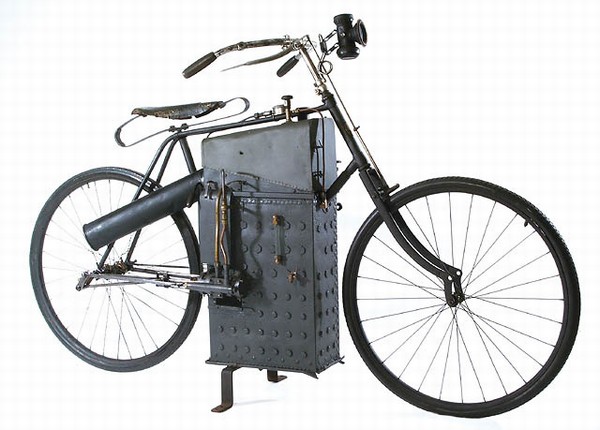
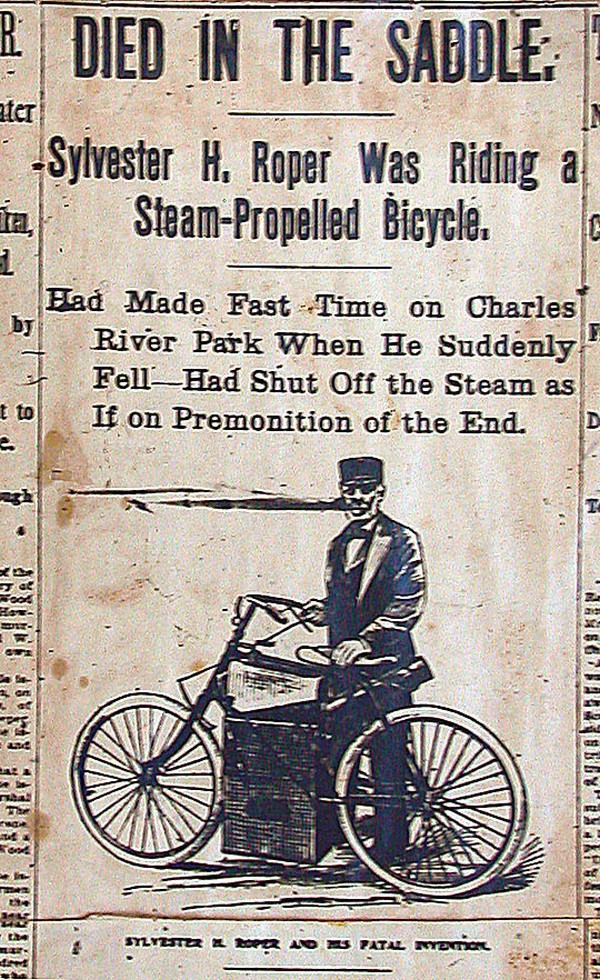 About
10 other steam-powered motocycles followed with the last being constructed
in 1895 (upper right photo). For this cycle Roper improved many
aspects of his steamer bike with support from the Pope Manufacturing
Company. Roper's last steam-powered bicycle included a one-gallon
water reservoir and provided about 8 miles of travel on one filling.
On test rides into town, Roper would remove the burning coals from the
firebox and place them in a small covered bucket. This would keep
steam from being generated and maintain the heat in the coals. When
he was ready to leave, he would re-stoke the fire, get up steam, and
return home.
About
10 other steam-powered motocycles followed with the last being constructed
in 1895 (upper right photo). For this cycle Roper improved many
aspects of his steamer bike with support from the Pope Manufacturing
Company. Roper's last steam-powered bicycle included a one-gallon
water reservoir and provided about 8 miles of travel on one filling.
On test rides into town, Roper would remove the burning coals from the
firebox and place them in a small covered bucket. This would keep
steam from being generated and maintain the heat in the coals. When
he was ready to leave, he would re-stoke the fire, get up steam, and
return home.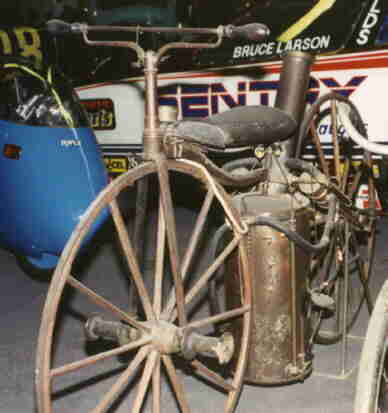 The announcement of
his death was covered in many newspapers including the Boston Daily Globe.
(above left).
The announcement of
his death was covered in many newspapers including the Boston Daily Globe.
(above left).